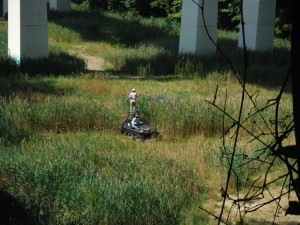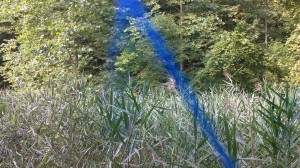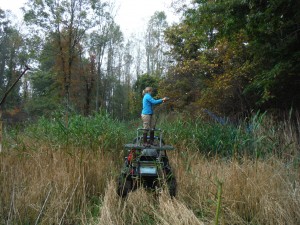May 2014
Karen Adair, the Central Lake Erie Watersheds Project Manager at The Nature Conservancy in Ohio, develops projects to holistically manage invasive species in Northeast Ohio watersheds. She recently shared tips for “Successful Phragmites Control” in a presentation to the Midwest Invasive Plants Network and the Ohio Invasive Plants Council. Her presentation was based on lessons learned from TNC preserves management and two Great Lakes Restoration Initiative projects TNC has developed and implemented to control invasive species on hundreds of acres of private and public lands throughout the Grand River and Ashtabula River watersheds. See highlights of the presentation below. Many of the techniques described are applicable region-wide.
Invasive Control Strategies
- Prevention
- Early detection, rapid response
- Start upstream/upwind
- Prioritize small populations (prevention – keep them from becoming big problems)
- Tackle large populations only if you can commit to multiple, consecutive years
- Know your disturbance – that will affect your control planning and results.
- If it was a one-time disturbance, your control will likely be more efficient/effective.
- If the disturbance persists in the system, your efforts will be more difficult, less efficient/effective, and on-going.
- Try to fix the disturbance if possible (restore hydrology, for instance).
Planning Strategies
- Know (as best as possible) what you’re up against.
- Determine the best use of your time and what will leverage your time the most. Is it grant writing (for the equipment/manpower you need or to hire a contractor who has it), coordinating volunteers, or backpack spraying yourself?
- Make sure you can commit. Everyone is working primarily from private or public funds. We cannot afford to waste them; from an ecological standpoint as well as our responsibility in showing and gaining trust of the general public that treatment can be successful.
4 R’s of Herbicide Application
- Right Equipment (and application method)
- Use appropriate scale of equipment for the population size (helicopter, marsh master, argo, tank sprayer, backpack, handwicking, etc.). Equipment size should diminish after first few years of initial treatments. Then follow-up often requires more manpower and smaller equipment and becomes more tedious/time consuming as natives re-establish and become the majority
- Right Mix (chemical, surfactant, dye & concentration)
- Herbicides such as Habitat offer an earlier treatment window, but have soil residual effects. Know your chemical. Ask people who have used it before if you haven’t.
- Glyphosate works well when applied correctly and late in the year
- Though surfactants/dyes don’t have the same EPA regulations as herbicides, look for those that do NOT say “do not use in or near water.” They may not say you can, but avoid those that say you cannot.
- Make sure you use a good dye you can easily see on the leaves, even hours after treatment. This ensures good overall coverage and allows you to see where you previously treated if you have to stop and come back later.
- Right Timing
- Know when the plant is most susceptible to treatment
- Phragmites has nice long treatment window – September to first frost with Glyphosate
- Consider the sensitivity of the plant community or landscape you’re working in – is there a best time for it? Do you need to avoid trampling, etc.?
- Right Coverage
- Don’t skimp on blue dye. Leaves should be obviously blue. Make sure you get good herbicide coverage on leaves as that can be one of the primary factors in success rate.
- AND follow-up, follow-up, follow-up
In a Nutshell
- Use your time wisely – leverage time for greatest output
- Don’t have expectations on timeframes – the biggest mistake people make is when they think a project has failed based on an arbitrary expectation. Especially at the site level, we often know little about the seed bank of invasives and natives and what post-treatment conditions will favor. Success should be based on a consistent decrease in invasives and a consistent increase in native recruitment/establishment.
- Get an Argo! – Argo, an amphibious vehicle, is an incredibly useful tool in invasives management. Ours has proven highly effective/useful in TNC’s northeast Ohio work. It can be equipped with a motorized spray tank for herbicide application. Large populations can be efficiently treated with an Argo by dividing the population into smaller sections (think of cutting a cake into slices). It can also be used in the winter to flatten Phragmites at a rate of about 1 acre/hour.
- Keep the big picture in perspective and be prepared for some off-target kills – Unless you’re working in a very sensitive area with rare species where extreme caution should be taken, remember that killing a few native, common species among thousands of its kind in the area may be the only way to comprehensively and efficiently control an invasion.
- If your application doesn’t work, re-evaluate your methods – To date, the only resistance known to Glyphosate is in agricultural plants. If your treatment isn’t effective, you have probably made a mistake in one or several of the 4 Rs of Herbicide Application.
For more information, contact Karen Adair at kadair@tnc.org.



